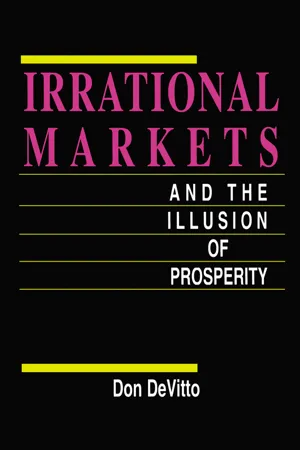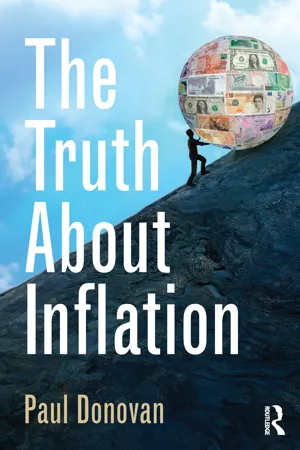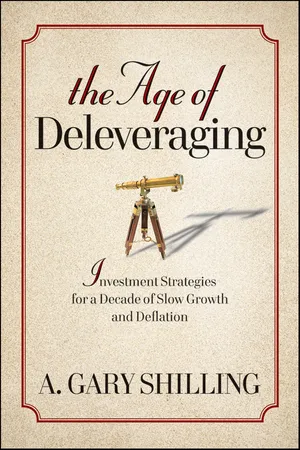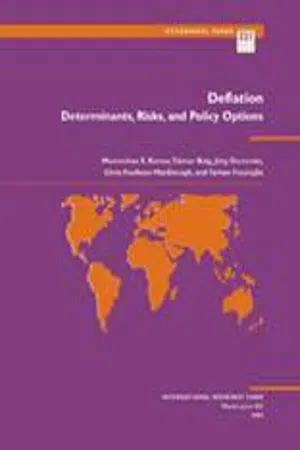Economics
Debt Deflation
Debt deflation refers to a situation where the overall level of prices in the economy falls, leading to an increase in the real burden of outstanding debt. This can result in a downward spiral as falling prices lead to lower incomes and asset values, making it harder for debtors to repay their debts, which in turn can further depress economic activity.
Written by Perlego with AI-assistance
8 Key excerpts on "Debt Deflation"
Learn about this page
Index pages curate the most relevant extracts from our library of academic textbooks. They’ve been created using an in-house natural language model (NLM), each adding context and meaning to key research topics.
- eBook - ePub
Fear and Greed
Investment risks and opportunities in a turbulent world
- Nicolas Sarkis(Author)
- 2012(Publication Date)
- Harriman House(Publisher)
These various choices are not mutually exclusive. As an economy grows naturally, some inflation usually occurs too, thus shrinking the debt in two ways simultaneously. There will also likely be some shrinkage of the debt from defaults and restructurings even if growth and inflation are in evidence. However, deleveraging periods are usually dominated by one of these three forces in particular.The optimal outcome is if the economy experiences genuine growth in order to ease its debt-burden. This can be a tall order in cases where debt is especially heavy, as the research of Reinhart and Rogoff has so ably demonstrated. In cases of heavy indebtedness, the natural tendency is often towards a deflationary collapse. The classic example of this was the Great Depression of the 1930s.Shortly after the 1929 to 1932 meltdown, Irving Fisher explained a deflationary debt-collapse in terms of a chain of consequences. First, investors seek to pay off debt en masse , resulting in distress-selling. In turn, this leads to shrinking bank credit and a falling stock of money. Prices then fall, squeezing profits and the value of assets. Trade contracts and businesses lay off workers, leading to lower confidence all round and money-hoarding. As prices fall, interest costs effectively rise.The science of economics has become more sophisticated since Fisher’s time, but his basic message still resonates. “It is always economically possible to stop or prevent such a depression simply by reflating the price level up to the average level at which outstanding debts were contracted by existing debtors and assumed by existing creditors, and then maintaining that level unchanged,” he wrote.[21]This logic has inspired the money-printing or quantitative easing exercises that central banks in the West have pursued in response to the latest crisis.Deleveraging through inflation
Although quantitative easing is not a new idea, the scale of these efforts over recent years has been unprecedented. Between 2008 and 2011, America’s Federal Reserve created more than $2 trillion out of thin air, which it has used in order to buy up US government bonds and other assets, and thereby pump money into the financial system. The Bank of England (BoE) was even more zealous in its approach, such that it owned an astonishing one-third of the total UK government bonds in issue as of early 2012. - Don DeVitto(Author)
- 2013(Publication Date)
- Routledge(Publisher)
C HAPTER 2 D EFLATION Until recently, the topic of deflation had received little attention in the financial press. This is not surprising; we haven’t encountered it since the 1930s. While deflation is typically thought of in purely economic terms, it also has a psychological aspect to it. Webster’s defines deflation as “a decrease in the amount of currency in a country.” No doubt, the monetary aspects of deflation are important. However to view deflation in a strictly monetary sense is insufficient. In simple terms, deflation is a state of falling prices. This state may arise due to a lack of currency or money, a lack of demand for goods, or an excess of supply. Usually, it’s a combination of all these factors. What’s critical to understand is that while the central bank of a country can to some extent control the supply of currency, governments have little control over the demand for goods, especially in today’s consumer-driven economies. The implication of this is that once a state of deflation emerges, it can become difficult, if not impossible, for a government to reverse the trend. This is where the psychology of the consumer is so important. If consumers are reluctant to spend, the impact of government policy, whether fiscal or monetary, is muted. Figure 2-1 U.S. Government Federal Net Outlays Source: Economagic.com The U.S. economy of the 1930s and Japan’s economy of the 1990s underscore the critical importance of consumer psychology: In both cases, governments used stimulative monetary and fiscal policies in an attempt to increase the demand for goods. In both cases, they largely failed. In the 1930s, America put its faith in fiscal policy to stimulate the moribund economy (see Figure 2-1). Government spending grew dramatically as a result of President Roosevelt’s New Deal. In spite of this massive effort, the unemployment rate in 1939, nearly 10 years after the onset of the depression, remained stubbornly high at 17 percent- eBook - ePub
Monetary Policy after the Great Recession
The Role of Interest Rates
- Arkadiusz Sieroń(Author)
- 2020(Publication Date)
- Routledge(Publisher)
Last but not least, low differentials between the average effective interest rate on government debt and the growth rate do not imply lower odds of sovereign defaults, as it is the interest rate on new government borrowing that matters. As Mauro and Zhou (2019, 3) find, “history teaches us that many crises have occurred after years of low differentials, and that market expectations can turn quickly and abruptly, shutting countries out of financial markets in a matter of a few months”.Conclusions
This chapter is related to the wider debate about the role of debt in the economy. Used wisely and in moderation, it can improve welfare, but when used imprudently and in excess, the result can be disastrous. I showed that although an increase in household debt can reflect financial deepening, in an environment of ultralow interest rates it may rather indicate a build-up of financial imbalances.Low interest rates and the resulting accumulation of debt can stimulate the economy in the short term, but they hamper long-term economic growth. As debt must be repaid, its accumulation may spur some growth today, but only at the expense of lower growth tomorrow. However, the accumulation of debt does not only shift economic growth in time, by borrowing from the future, but also lowers the whole path of economic growth. This is because the high level of debt spurred by low interest rates increases the probability of large economic crashes, while reducing the economy’s resilience to them, and misallocates resources, even in good times.What is important here is that there is also a reverse relationship: high levels of debt make an increase in interest rates more difficult. This is because of political pressure and also because “in a high-debt economy, interest rate hikes could be more contractionary than cuts are expansionary” (Zabai 2017). In other words, the prolonged period of low interest rates can result in a debt trap: the cheap credit makes debt financing more affordable, but the accumulation of debt would require more spending on servicing the debt. In such an environment, any increase in interest rates could be detrimental for borrowers. Hence, although El-Erian (2016) might be right in claiming that central banks become the only game in town, this is because of the high level of debt, which was caused partially by themselves in the first place. For example, the European Central Bank (2016) estimates that under an assumption of no policy change, aggregate euro-area public debt as a percentage of GDP would decline from around 94 percent in 2015 to around 84 percent in the coming decade, while an interest rate 0.5 percentage points higher would put debt on an increasing path toward the end of the scenario horizon. - eBook - ePub
- Paul Donovan(Author)
- 2015(Publication Date)
- Routledge(Publisher)
The belief that ‘inflation reduces debt’ has pervaded and perverted financial markets for too many years. Under the right circumstances for a borrower, or wrong circumstances for a lender, inflation can lead to a real reduction in the debt burden. However, the relationship between debt and inflation is complex, and investors must be very, very wary of falling into the trap of subtracting consumer price inflation rates from the interest rate costs of debt to get a sense of whether inflation is eroding real debt values.The consumer is, in the developed world at least, the most important part of the economy. For the most part an investor is not going to be concerned with consumer debt as an investable asset class, but should focus on consumer behaviour in the economy and how consumer debt may impact that.Corporate debt is a different matter. Most corporate debt is not investable, because small and medium-sized companies – and even some quite large companies – are not able to borrow from the corporate bond markets. These corporates are important to the overall performance of the economy, as the recent global financial crisis has demonstrated. This last recession has been a small-business recession, and the unusually sluggish nature of the recovery owes much to the reluctance of small businesses to take on debt.In the wake of the increase in public sector debt that the developed and several emerging economies have experienced, it has to be government debt that attracts most attention. The debt–inflation myth is a concern here because it gives rise to a fear that governments will, indeed that governments are able to, inflate their way out of debt. In the nineteenth and early twentieth centuries it was perfectly possible for governments to inflate their way out of debt; debt was long duration or perpetual, and little if any spending was tied to the level of inflation. There were still elements of this structure in the great inflation of the 1970s. The world today is not the same as it was nearly a half century ago, and governments will find inflation a problem, in particular if it raises inflation uncertainty risk.Government debt management today seems to be moving in a different direction from inflation. Financial repression may be a by-product of other, more worthy aims (risk management and prudential regulation generally have the most moral of objectives, at least in theory). The consequence is that the government is able to lower its costs of borrowing in nominal terms without resorting to inflation. As long as some investors can be held captive, governments seem likely to incline their policies towards repression rather than inflation. - eBook - ePub
Japan's Long Stagnation, Deflation, and Abenomics
Mechanisms and Lessons
- Kenji Aramaki(Author)
- 2019(Publication Date)
- Palgrave Macmillan(Publisher)
Annual Economic and Fiscal Report FY 2001, pp. 43–49, of the Cabinet Office argued that the good deflation arguments have problems: First, the arguments do not properly distinguish between changes of prices of specific items (relative price change) and deflation (decline in general price level). Second, decline in general price level does do harm to the economy. Under deflation, the burden of debt in real terms increases, depressing investment. If the nominal interest rates or nominal wages do not fall to the same extent as the general price level falls, the real interest rates or the real wages rise, depressing investment and employment. Deflation may be beneficial to the lenders for whom the real value of interest and principal repayments increase and those employees whose employment and wages are protected; it is disadvantageous to borrowers and new entrants to labor markets who may be squeezed out. In total, deflation discourages investment and is detrimental to employment, bringing about significant damage to the economy. Some media favored the “good deflation” argument. For example, Mainichi Newspaper on March 17, 2001, in an article entitled “Deflation, Do Not Stop Prices from Falling,” argued that price drops in recent years were due to import penetration or deregulation, and therefore desirable. The article criticized the government’s interpretation of the price developments at that time as deflation, as stated in the government monthly economic report on March 16, 2001. The government report wrote that, if deflation is defined to mean continuous decline in prices, then the Japanese economy is under a mild deflation.13The manuscript of the press conference by the Governor on May 20, 1999 (BOJ 1999a ). Governor Hayami also stated in another press conference that the BOJ had been providing sufficient funds to the financial markets under the zero interest policy, and even if additional finance was provided, further monetary easing effects would not be expected. See the manuscript of the press conference, September 21, 1999 (BOJ 1999c - eBook - ePub
The Age of Deleveraging
Investment Strategies for a Decade of Slow Growth and Deflation
- A. Gary Shilling(Author)
- 2010(Publication Date)
- Wiley(Publisher)
I've identified seven types of inflation/deflation that may occur individually but often happen simultaneously or in sequence as they interact with and promote each other. The huge spending on the Vietnam War and Great Society programs, starting in the mid-1960s, spawned first commodity inflation in the early 1970s, then a wage-price spiral and general CPI-style inflation. Currency deflation and general inflation both resulted from excessive money creation in Germany in the 1920s, China in the late 1940s, and Zimbabwe today.Financial asset deflation in stocks in the years 2000–2002 and again in 2008–2009 as well as the tangible asset deflation in houses have sired a consumer saving spree along with other forces that should generate CPI-style general deflation. Commodity deflation has also curtailed spending by producers and therefore slower global growth and CPI deflation. Protectionism resulting from the deflationary, high-unemployment global economy may spur competitive devaluations—currency deflation that leads to retaliation and slows worldwide growth. That would enhance other forms of deflation.Five of the seven forms of deflation are in place, and are largely understood by investors. Increasingly, observers realize that cuts in wages and hours worked are being used to reduce labor costs in addition to layoffs (wage-price deflation). The collapse in 2008 in commodities, and more recent weakness, is obvious to all (commodity deflation). Commercial real estate deflation is increasingly seen as another serious threat to the financial system and adds to housing price weakness (tangible asset deflation). The 2000–2002 and 2007–2009 stock collapses as well as the more recent slide are vivid to most investors (financial asset deflation). The dollar's strength in late 2008 and early 2009 as well as in early 2010 is well known.The least accepted variety of deflation remains general price declines, or CPI deflation, as we've dubbed it. If we're right and the CPI and PPI fall chronically by 2 to 3 percent per year, that will be a big shock to almost everyone else who expects the opposite. Unlike CPI inflation, which is generally considered undesirable, deflation comes in two flavors: the good deflation of excess supply and the bad deflation of deficient demand. - Taimur Baig, Jörg Decressin, Tarhan Feyzioglu, Manmohan Kumar, and Chris Faulkner-MacDonagh(Authors)
- 2003(Publication Date)
- INTERNATIONAL MONETARY FUND(Publisher)
III Historical Experiences of Deflation and Policy Lessons
In view of the discussion in the previous section of the determinants and costs of deflation, an examination of the empirical evidence regarding persistent deflation is useful. Prior to the onset of deflation in Japan from the mid-1990s onward, there had been few sustained deflationary episodes in the post–World War II period in the major economies. Among industrial countries, Canada, Norway, and Sweden had small and short-lived declines in aggregate measures of prices in the late 1980s; and the private consumption deflator fell in Germany in 1986 (mainly due to a supply shock) and in Japan in 1988. Several Scandinavian countries experienced a bursting of an asset price bubble, a sharp decline in output, and severe banking sector distress in the late 1980s and early 1990s. However, these were not generally accompanied by falling aggregate prices. A number of emerging market and developing countries also experienced declines in prices up to the mid-1990s. But the declines were generally short-lived, reflecting natural disasters or severe declines in terms of trade of commodity exporters (IMF, 1999; the CFA Franc Zone countries have experienced similar price shocks). Nonetheless, as noted earlier, the frequency of price declines in both industrial and emerging market countries has been clearly increasing over time.For an assessment of periods of pronounced and sustained declines in prices, one needs to consider the pre–World War II period. The discussion below focuses on two periods: the last quarter of the nineteenth century, when mild but persistent deflation in industrial countries in the first half of the period was followed by inflation in the second half; and the 1930s, when severe deflation lasted for a shorter period, but was accompanied by far more severe consequences. The paper examines the United States, Japan, and Sweden during this period.9- eBook - ePub
- Lionel Robbins(Author)
- 2017(Publication Date)
- Routledge(Publisher)
THE CAUSES OF DEFLATION1. A FLUCTUATION of the kind described in the last chapter is bound to be followed by a period of extensive depression. The errors of anticipation which led to the disaster have been discovered. Adjustment must be made to the new situation. While this takes place some factors of production will be unemployed, some funds of liquid capital will be left idle at the banks. Moreover, the general shock to confidence is likely to accentuate this process. Investors will fight shy of active investment. Bonds will be preferred to equities. More money will tend to be left on deposit. The coming of depression is almost certain to be accompanied by some measure of deflation.But, in a system undisturbed by other causes making for depression, there seems no reason to suppose that this process need go very far. The experience of similar fluctuations in the pre-war period seems to suggest that, after a certain interval of liquidation and cost cutting, business prospects will once more brighten and revival will gradually take place. In the present depression things have been different. Whether or not revival is now on the way, there can be no doubt that the deflationary process which preceded it has been one of quite unparalleled severity. The explanation which we have examined already provides an account of how the slump originated. But it certainly does not explain why it has been so severe. Our next task, therefore, is to examine this problem. What have been the causes of the severity of the depression?At the outset of the inquiry, one thing is clear. No single explanation of this phenomenon will be sufficient. The genesis of the slump may be traced to the collapse of a general inflationary movement which might be regarded as a single cause. But the subsequent course of the slump has been so obviously affected by a multiplicity of influences that any attempt to bring them under one heading must necessarily involve oversimplification. Political accidents, deliberate policies, structural weaknesses, local psychology, have all played a part which cannot be ignored. Nor is it possible at this stage to assign exact quantitative importance to these influences. Who can diagnose with certainty the relative importance of the part played by political power and the part played by bad banking policy, not to mention personal dishonesty, in the causation of the German Banking Crisis? What weight are we to assign to the peculiar psychology of the American people, what weight to the mechanical difficulties of their debt structure, in explaining the collapse of last spring? Clearly the time has not yet come, if it ever will, for exact assessment of exact causal priority in this history. All that can be done is to ascertain the existence of certain tendencies and to explain their mode of operation.







